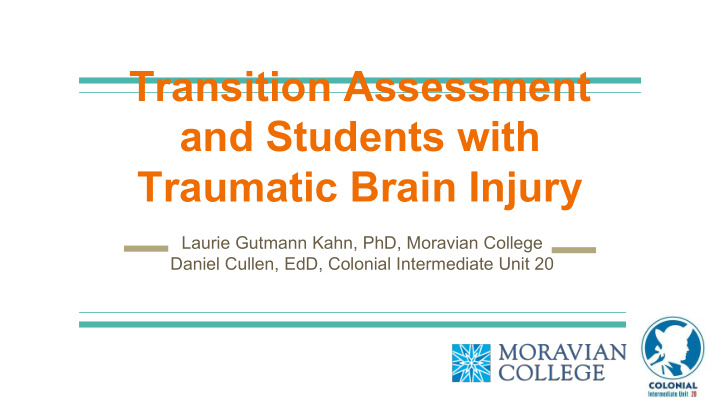



Transition Assessment and Students with Traumatic Brain Injury Laurie Gutmann Kahn, PhD, Moravian College Daniel Cullen, EdD, Colonial Intermediate Unit 20
Assessment and Students with ● Introductions Traumatic Brain ● Learning Intentions ● Transition Assessments Injury ● Barriers to Transition for Students with TBI CBIRT Webinar ● Application and Agenda Implementation 9/19/2019 ● Wrap-Up with Questions & Comments
Learning Intentions: ● To gain an understanding of the use of transition assessments and how they benefit students with Traumatic Brain Injury ● To identify best practices that engineer post-secondary outcomes for school age students who sustain a traumatic brain injury ● To build capacity for implementation of the identified best practices engineered for maximum impact as they transform barriers into bridges for game changing post-secondary outcomes
Transition Assessments “An ongoing and coordinated process that begins in the middle school years and continues until students with disabilities graduate or exit the school system. Transition assessment assists students with disabilities and their families to identify and plan for postsecondary goals and adult roles .”* (Clark, 2010) *emphasis added by presenters 1 2 3 4
Transition Assessment: a process for determining a student’s PINS. Those are then used to identify appropriate goals, instruction, supports, and services to support their transition to adult life
IDEA 2004 Post-Secondary Goals ● IEPs must include appropriate measurable postsecondary goals based upon age -appropriate transition assessments based upon their PINS ● Related to further education, employment, and independent living ● Best Practices = Student Focused Assessment ○ Student involvement in assessment completion ○ Student included in the analysis of results
Background: The Barriers for Students Experiencing TBI and the Transition to Adulthood ● Traumatic Brain Injury is most likely to occur in young people ages 15 - 19 ● Lack of Training for Pre-Service Teachers/In-Service Teachers ● Dearth of Collaboration Opportunities ○ Health Care ○ School ○ Home ○ Vocational Training Opportunities ● Decreased engagement in the school setting (Drop out rate, suspension/expulsion rate) ● Loss of grit and determination to accomplish the aspiration or post-secondary goal (due to ableism and environmental/attitudinal barriers) ● Lack of knowledge regarding available supports and resources Children’s Hospital of Philadelphia, 2019
Transition Assessments for Young Adults experiencing a TBI ● Students who had transition goals for postsecondary education were more likely to be employed at some point post-high school. ● Students who were actively engaged and took a leadership role in the transition planning process had greater levels of post-secondary success. ● Importance of student, school, and outside agency engagement in transition planning process. (Wehman, Chen, West, & Cifu, 2014)
Supporting Data - National Longitudinal Transition Study 2 - Post-Secondary Employment Outcomes Preparation / Assessment / Informs / Training / Outcome / Disconnection 56.4% Were not employed at the time of graduation 27.6% Reported Employment Outcomes 7.3% At and Under the age of 14 Reported Planning 15.0% At or Above the age of 15 Reported Planning
At the Starting Line - Presume they Can!
Best Practices = Power Tools Presume Competence - This Starts the Process! 1. Believe in the “Can Do” 2. Support the “Can Do” Belief through the implementation of a highly intentional Assessment protocol process that defines evidence-based transition assessments that inform planning / activities in the areas of independent living, education and training, and career readiness at each transition age interval. 3. Re-design perspective on the continuum of services offered 4. View Programs that can be leveraged, combined, integrated, and designed to build capacity 5. Frame pathways using meaningful ongoing assessment data as the process driver 6. Partner with service industry leaders who share a mission filled with care. 7. Leverage a community care-based partnerships to create pathways for community access and and job embedded volunteer experiences as part of a comprehension transition assessment process 8. Partner with state and county based service agencies to equip families with the knowledge and planning that are needed for funding job development training, supported or independent living, transportation, respit, and community access post high school graduation
Apply and Implement - Step 1 - Build Capacity
Apply and Implement - Step 2 - Frame Intention
Apply and Implement Step 3 - Build & Leverage a Community of Partners Build A Community of Partners By Design - St. Luke’s University Health Network, 2019 Trading the Classroom for Work one Day A Week - Channel 69 News, 2019 Resort Training Students with Disabilities - PA Homepage, 2016 Brain Steps - Strategies Teaching Educators, Parents, and Students The Local YMCA Local Colleges and Universities Panera Bread
Big Takeaways ● Presuming competence, allowing the assessments to fill in their specific preferences, interests, needs, and strengths through data collection and analysis. ● Active Student Involvement: Involving the student in both the assessment data collection as well as the results to allow them to make decisions regarding their transition goals and services. ● Collaboration to benefit the student: Leverage individual program supports that collaborative build capacity and propel students towards their post- secondary outcomes. ● Systemic re-evaluation of PINS as students move throughout their educational trajectory.
Additional Resources Transition to Adulthood for Youth with Traumatic Brain Injury and Intellectual / Developmental Disabilities - Children’s Hospital of Philadelphia, 2019 Transition Tool Kit for Best Practices for Students with Traumatic Brain Injury - Center for Brain Injury, Research, and Training Overview of Assessment for Transition Planning - National Technical Assistance Center on Transition Assessment Tool Kit Transition Assessment Matrix - Indiana Secondary Transition Resource Center
Contact Information Laurie Gutmann Kahn, PhD, Moravian College ● kahnl@moravian.edu Daniel Cullen, EdD, Colonial Intermediate Unit 20 ● Email: dcullen@ciu20.org ● @CIU20SuperLSS
Recommend
More recommend